Xipeng Qiu
How to Set the Batch Size for Large-Scale Pre-training?
Jan 08, 2026Abstract:The concept of Critical Batch Size, as pioneered by OpenAI, has long served as a foundational principle for large-scale pre-training. However, with the paradigm shift towards the Warmup-Stable-Decay (WSD) learning rate scheduler, we observe that the original theoretical framework and its underlying mechanisms fail to align with new pre-training dynamics. To bridge this gap between theory and practice, this paper derives a revised E(S) relationship tailored for WSD scheduler, characterizing the trade-off between training data consumption E and steps S during pre-training. Our theoretical analysis reveals two fundamental properties of WSD-based pre-training: 1) B_min, the minimum batch size threshold required to achieve a target loss, and 2) B_opt, the optimal batch size that maximizes data efficiency by minimizing total tokens. Building upon these properties, we propose a dynamic Batch Size Scheduler. Extensive experiments demonstrate that our revised formula precisely captures the dynamics of large-scale pre-training, and the resulting scheduling strategy significantly enhances both training efficiency and final model quality.
How to Set the Learning Rate for Large-Scale Pre-training?
Jan 08, 2026Abstract:Optimal configuration of the learning rate (LR) is a fundamental yet formidable challenge in large-scale pre-training. Given the stringent trade-off between training costs and model performance, the pivotal question is whether the optimal LR can be accurately extrapolated from low-cost experiments. In this paper, we formalize this investigation into two distinct research paradigms: Fitting and Transfer. Within the Fitting Paradigm, we innovatively introduce a Scaling Law for search factor, effectively reducing the search complexity from O(n^3) to O(n*C_D*C_η) via predictive modeling. Within the Transfer Paradigm, we extend the principles of $μ$Transfer to the Mixture of Experts (MoE) architecture, broadening its applicability to encompass model depth, weight decay, and token horizons. By pushing the boundaries of existing hyperparameter research in terms of scale, we conduct a comprehensive comparison between these two paradigms. Our empirical results challenge the scalability of the widely adopted $μ$ Transfer in large-scale pre-training scenarios. Furthermore, we provide a rigorous analysis through the dual lenses of training stability and feature learning to elucidate the underlying reasons why module-wise parameter tuning underperforms in large-scale settings. This work offers systematic practical guidelines and a fresh theoretical perspective for optimizing industrial-level pre-training.
WESR: Scaling and Evaluating Word-level Event-Speech Recognition
Jan 08, 2026Abstract:Speech conveys not only linguistic information but also rich non-verbal vocal events such as laughing and crying. While semantic transcription is well-studied, the precise localization of non-verbal events remains a critical yet under-explored challenge. Current methods suffer from insufficient task definitions with limited category coverage and ambiguous temporal granularity. They also lack standardized evaluation frameworks, hindering the development of downstream applications. To bridge this gap, we first develop a refined taxonomy of 21 vocal events, with a new categorization into discrete (standalone) versus continuous (mixed with speech) types. Based on the refined taxonomy, we introduce WESR-Bench, an expert-annotated evaluation set (900+ utterances) with a novel position-aware protocol that disentangles ASR errors from event detection, enabling precise localization measurement for both discrete and continuous events. We also build a strong baseline by constructing a 1,700+ hour corpus, and train specialized models, surpassing both open-source audio-language models and commercial APIs while preserving ASR quality. We anticipate that WESR will serve as a foundational resource for future research in modeling rich, real-world auditory scenes.
MOSS Transcribe Diarize: Accurate Transcription with Speaker Diarization
Jan 08, 2026Abstract:Speaker-Attributed, Time-Stamped Transcription (SATS) aims to transcribe what is said and to precisely determine the timing of each speaker, which is particularly valuable for meeting transcription. Existing SATS systems rarely adopt an end-to-end formulation and are further constrained by limited context windows, weak long-range speaker memory, and the inability to output timestamps. To address these limitations, we present MOSS Transcribe Diarize, a unified multimodal large language model that jointly performs Speaker-Attributed, Time-Stamped Transcription in an end-to-end paradigm. Trained on extensive real wild data and equipped with a 128k context window for up to 90-minute inputs, MOSS Transcribe Diarize scales well and generalizes robustly. Across comprehensive evaluations, it outperforms state-of-the-art commercial systems on multiple public and in-house benchmarks.
Multi-hop Reasoning via Early Knowledge Alignment
Dec 23, 2025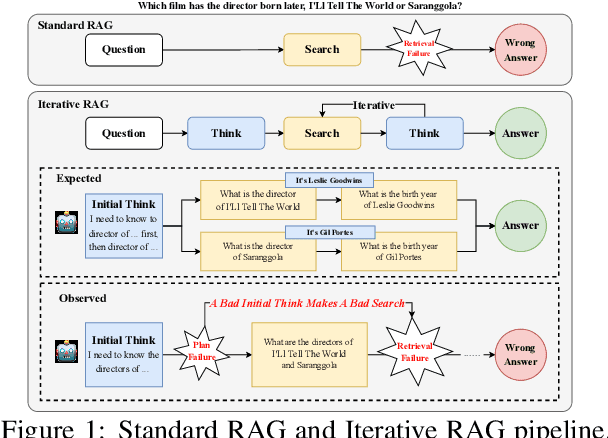


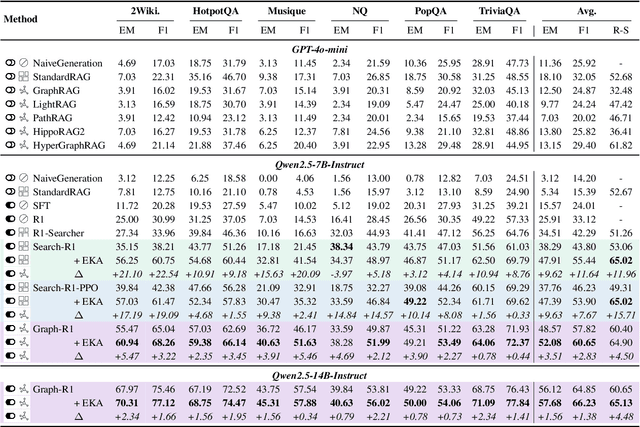
Abstract:Retrieval-Augmented Generation (RAG) has emerged as a powerful paradigm for Large Language Models (LLMs) to address knowledge-intensive queries requiring domain-specific or up-to-date information. To handle complex multi-hop questions that are challenging for single-step retrieval, iterative RAG approaches incorporating reinforcement learning have been proposed. However, existing iterative RAG systems typically plan to decompose questions without leveraging information about the available retrieval corpus, leading to inefficient retrieval and reasoning chains that cascade into suboptimal performance. In this paper, we introduce Early Knowledge Alignment (EKA), a simple but effective module that aligns LLMs with retrieval set before planning in iterative RAG systems with contextually relevant retrieved knowledge. Extensive experiments on six standard RAG datasets demonstrate that by establishing a stronger reasoning foundation, EKA significantly improves retrieval precision, reduces cascading errors, and enhances both performance and efficiency. Our analysis from an entropy perspective demonstrate that incorporating early knowledge reduces unnecessary exploration during the reasoning process, enabling the model to focus more effectively on relevant information subsets. Moreover, EKA proves effective as a versatile, training-free inference strategy that scales seamlessly to large models. Generalization tests across diverse datasets and retrieval corpora confirm the robustness of our approach. Overall, EKA advances the state-of-the-art in iterative RAG systems while illuminating the critical interplay between structured reasoning and efficient exploration in reinforcement learning-augmented frameworks. The code is released at \href{https://github.com/yxzwang/EarlyKnowledgeAlignment}{Github}.
DiRL: An Efficient Post-Training Framework for Diffusion Language Models
Dec 23, 2025Abstract:Diffusion Language Models (dLLMs) have emerged as promising alternatives to Auto-Regressive (AR) models. While recent efforts have validated their pre-training potential and accelerated inference speeds, the post-training landscape for dLLMs remains underdeveloped. Existing methods suffer from computational inefficiency and objective mismatches between training and inference, severely limiting performance on complex reasoning tasks such as mathematics. To address this, we introduce DiRL, an efficient post-training framework that tightly integrates FlexAttention-accelerated blockwise training with LMDeploy-optimized inference. This architecture enables a streamlined online model update loop, facilitating efficient two-stage post-training (Supervised Fine-Tuning followed by Reinforcement Learning). Building on this framework, we propose DiPO, the first unbiased Group Relative Policy Optimization (GRPO) implementation tailored for dLLMs. We validate our approach by training DiRL-8B-Instruct on high-quality math data. Our model achieves state-of-the-art math performance among dLLMs and surpasses comparable models in the Qwen2.5 series on several benchmarks.
Beyond Real: Imaginary Extension of Rotary Position Embeddings for Long-Context LLMs
Dec 08, 2025Abstract:Rotary Position Embeddings (RoPE) have become a standard for encoding sequence order in Large Language Models (LLMs) by applying rotations to query and key vectors in the complex plane. Standard implementations, however, utilize only the real component of the complex-valued dot product for attention score calculation. This simplification discards the imaginary component, which contains valuable phase information, leading to a potential loss of relational details crucial for modeling long-context dependencies. In this paper, we propose an extension that re-incorporates this discarded imaginary component. Our method leverages the full complex-valued representation to create a dual-component attention score. We theoretically and empirically demonstrate that this approach enhances the modeling of long-context dependencies by preserving more positional information. Furthermore, evaluations on a suite of long-context language modeling benchmarks show that our method consistently improves performance over the standard RoPE, with the benefits becoming more significant as context length increases. The code is available at https://github.com/OpenMOSS/rope_pp.
SRPO: Self-Referential Policy Optimization for Vision-Language-Action Models
Nov 19, 2025Abstract:Vision-Language-Action (VLA) models excel in robotic manipulation but are constrained by their heavy reliance on expert demonstrations, leading to demonstration bias and limiting performance. Reinforcement learning (RL) is a vital post-training strategy to overcome these limits, yet current VLA-RL methods, including group-based optimization approaches, are crippled by severe reward sparsity. Relying on binary success indicators wastes valuable information in failed trajectories, resulting in low training efficiency. To solve this, we propose Self-Referential Policy Optimization (SRPO), a novel VLA-RL framework. SRPO eliminates the need for external demonstrations or manual reward engineering by leveraging the model's own successful trajectories, generated within the current training batch, as a self-reference. This allows us to assign a progress-wise reward to failed attempts. A core innovation is the use of latent world representations to measure behavioral progress robustly. Instead of relying on raw pixels or requiring domain-specific fine-tuning, we utilize the compressed, transferable encodings from a world model's latent space. These representations naturally capture progress patterns across environments, enabling accurate, generalized trajectory comparison. Empirical evaluations on the LIBERO benchmark demonstrate SRPO's efficiency and effectiveness. Starting from a supervised baseline with 48.9% success, SRPO achieves a new state-of-the-art success rate of 99.2% in just 200 RL steps, representing a 103% relative improvement without any extra supervision. Furthermore, SRPO shows substantial robustness, achieving a 167% performance improvement on the LIBERO-Plus benchmark.
RLoop: An Self-Improving Framework for Reinforcement Learning with Iterative Policy Initialization
Nov 06, 2025



Abstract:While Reinforcement Learning for Verifiable Rewards (RLVR) is powerful for training large reasoning models, its training dynamics harbor a critical challenge: RL overfitting, where models gain training rewards but lose generalization. Our analysis reveals this is driven by policy over-specialization and catastrophic forgetting of diverse solutions generated during training. Standard optimization discards this valuable inter-step policy diversity. To address this, we introduce RLoop, a self-improving framework built on iterative policy initialization. RLoop transforms the standard training process into a virtuous cycle: it first uses RL to explore the solution space from a given policy, then filters the successful trajectories to create an expert dataset. This dataset is used via Rejection-sampling Fine-Tuning (RFT) to refine the initial policy, creating a superior starting point for the next iteration. This loop of exploration and exploitation via iterative re-initialization effectively converts transient policy variations into robust performance gains. Our experiments show RLoop mitigates forgetting and substantially improves generalization, boosting average accuracy by 9% and pass@32 by over 15% compared to vanilla RL.
Thinking with Video: Video Generation as a Promising Multimodal Reasoning Paradigm
Nov 06, 2025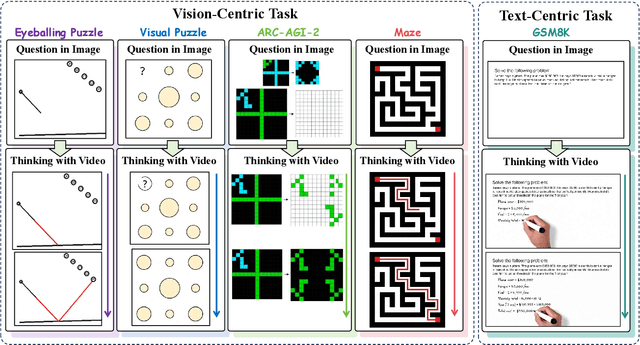
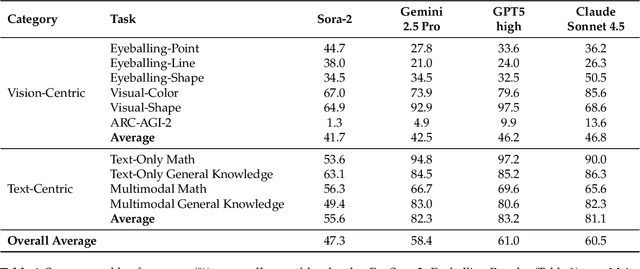
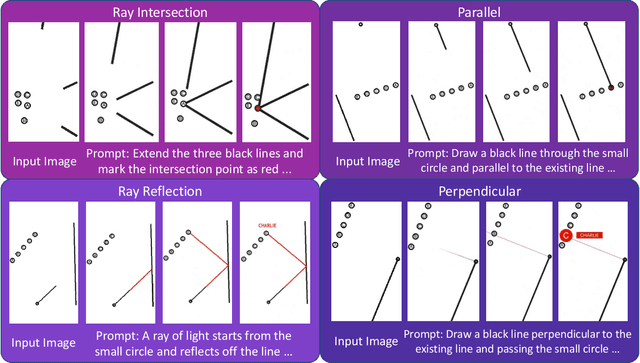

Abstract:"Thinking with Text" and "Thinking with Images" paradigm significantly improve the reasoning ability of large language models (LLMs) and Vision Language Models (VLMs). However, these paradigms have inherent limitations. (1) Images capture only single moments and fail to represent dynamic processes or continuous changes, and (2) The separation of text and vision as distinct modalities, hindering unified multimodal understanding and generation. To overcome these limitations, we introduce "Thinking with Video", a new paradigm that leverages video generation models, such as Sora-2, to bridge visual and textual reasoning in a unified temporal framework. To support this exploration, we developed the Video Thinking Benchmark (VideoThinkBench). VideoThinkBench encompasses two task categories: (1) vision-centric tasks (e.g., Eyeballing Puzzles), and (2) text-centric tasks (e.g., subsets of GSM8K, MMMU). Our evaluation establishes Sora-2 as a capable reasoner. On vision-centric tasks, Sora-2 is generally comparable to state-of-the-art (SOTA) VLMs, and even surpasses VLMs on several tasks, such as Eyeballing Games. On text-centric tasks, Sora-2 achieves 92% accuracy on MATH, and 75.53% accuracy on MMMU. Furthermore, we systematically analyse the source of these abilities. We also find that self-consistency and in-context learning can improve Sora-2's performance. In summary, our findings demonstrate that the video generation model is the potential unified multimodal understanding and generation model, positions "thinking with video" as a unified multimodal reasoning paradigm.
 Add to Chrome
Add to Chrome Add to Firefox
Add to Firefox Add to Edge
Add to Edge